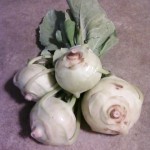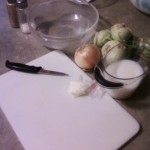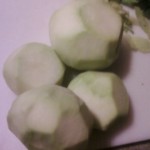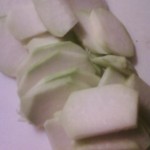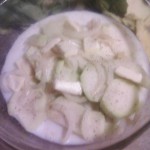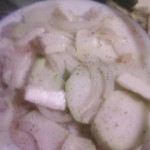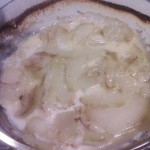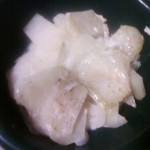This Meatless Monday, we feature Kohlrabi, with growing, storage and prep tips, as well as recipes for Scalloped Kohlrabi and Kohlrabi Soup.
Background
Kohlrabi, also sometimes called “German turnip,” is a member of the cabbage family. The part of kohlrabi that is most commonly eaten does in fact resemble a turnip, but it isn’t a root at all. Kohlrabi plants form a very swollen, bulbous stem just above the ground and small, kale-like leaves shoot up off of it. The edible bulbous portion is usually pale green but can also be purple depending upon the variety. Kohlrabi has a flavor similar to that of broccoli stems or mild cabbage, but it is generally sweeter, juicier, and more tender. Kohlrabi greens can also be prepared like other cooking greens. Some varieties of kohlrabi are grown for animal feed and, in general, the vegetable in much more common in Europe than in the United States. It is native to the cooler climates of northern Europe.
Growing Tips
Like almost all members of the cabbage family, kohlrabi prefers somewhat cool, mild weather. Seeds will germinate in very cold temperatures, so you may sow seeds as soon as the soil can be worked in the spring. For a bit of a jump on the season, starts seeds indoors a few weeks early. It takes only about 6-8 weeks for a young kohlrabi seedling to reach maturity, so you may plant another crop if you wish to have a second harvest. You also may wish to stagger several seedlings if you don’t want to wind up with too much kohlrabi at once! Kohlrabi appreciates well-drained soil, consistent watering, and soil with plenty of compost mixed in. Most kohlrabi is best if harvested when the plant reaches 3 – 4 inches in diameter–any larger and the flesh will become tough and woody (with the exception of a few varieties, such as Gigante). Plants can withstand light frosts but not prolonged freezing temperatures.
Storage
To store, trim off the leafy stems and any roots still attached. Rinse, towel dry, and refrigerate in plastic bags for up to several weeks. For long-term storage, kohlrabi can be frozen. Simply peel, chop into chunks, blanch for 2-3 minutes, cool, and then freeze. To keep the chunks from all sticking together, you may first freeze them on cookie sheets and then transfer them to freezer bags.
Nutritional Benefits
Eating kohlrabi is a great way to get more vitamin C, dietary fiber, and potassium into your diet! It also contains Vitamin A, folic acid, and calcium. Like many vegetables, kohlrabi is low in calories and fat. Its high fiber content makes it reasonably filling.
Preparation
Kohlrabi is tasty both raw and cooked. Smaller kohlrabi will have tender skin, but you may want to peel larger, tougher ones before eating. Try throwing raw kohlrabi into salads or chopping it into strips and eating with a veggie dip as you would broccoli. Kohlrabi can be steamed, sautéed, boiled, roasted, braised, or added to many of your favorite dishes.
Meatless Monday Recipe: Scalloped Kohlrabi
Janice Santiago, a volunteer baking, tasting and testing recipes out of the Vermont Fresh Handbook tried out this Scalloped Kohlrabi recipe. She said, “Kohlrabi was hard to find!! I looked in so many places, farmstands, etc. – a couple farmers had it, but I didn’t make it to farmer’s market. Finally ended up calling City Market in Burlington and they had some…Recipe – no way did what I use make enough for 6 people. There was enough for 2-3 people, but maybe my “medium” ones were too small and too few. I would definitely add more kohlrabi to the list and more onions. I tend to love onions, especially in scalloped potatoes. The recipe should state what size baking dish – because, again, the size and shape will impact the cooking time. I used a 2-qt covered dish. For the amount of onion/kohlrabi, 1 cup of milk seemed like a lot. I would reduce that again, more eyeing it, depending on amount of main ingredients. Not sure if it’s a big deal, but I use unsalted butter in my cooking – this recipe doesn’t specify, but if you’re salting and peppering the kohlrabi, you probably don’t want extra butter in the dish. I baked covered for awhile and then took the cover off to get golden brown top to the dish, but it wasn’t even an hour at 400. I let the dish sit for a few minutes before having some. There was too much liquid for me, but that was easily drained off while serving. I could have eaten much more of this!! I will definitely look for this at farmer’s markets, try to find cheaper, etc.. and see if I can find larger so fewer are needed. I will make this dish again!! What a great alternative to potatoes!”
Serves 6 (Janice says 2-3)
(adapted from cookitsimply.com)
Ingredients
- 2 tablespoons butter
- 1 onion, thinly sliced
- 4 medium kohlrabi
- Salt and pepper
- 1 cup milk
- Chopped fresh parsley to garnish (optional)
Instructions
- Preheat oven to 400°F.
- Melt 1 tablespoon of the butter in a heavy saucepan over medium heat, then cook onions until slightly tender. Remove from heat and allow to cool slightly.
- Peel kohlrabi and slice thinly.
- Grease a casserole dish with some of the butter. Layer the kohlrabi and onions in the dish, seasoning the kohlrabi layers with salt and pepper.
- Pour the milk over the top of the vegetables and dot with any remaining butter.
- Cook for about 1.5 hours or until vegetables are very tender.
- Serve hot, garnished with parsley.
- Photo courtesy of Janice Santiago
- Photo courtesy of Janice Santiago
- Photo courtesy of Janice Santiago
- Photo courtesy of Janice Santiago
- Photo courtesy of Janice Santiago
- Photo courtesy of Janice Santiago
- Photo courtesy of Janice Santiago
- Photo courtesy of Janice Santiago
- Photo courtesy of Janice Santiago
Meatless Monday Recipe: Kohlrabi Soup
Serves 6
(adapted from cookitsimply.com)
Ingredients
- 3 medium kohlrabi
- 4 strips bacon
- 1 onion, chopped
- 1 carrot, chopped
- 2 large potatoes, diced
- 2 tablespoons olive oil
- 3 teaspoons garlic
- 8 cups stock or water
- Salt and pepper
Instructions
- Peel and dice kohlrabi.
- Heat a large saucepot over medium heat and fry the bacon until crispy. Set bacon aside, then cook onions in bacon grease (discarding some if you like) until tender and translucent.
- Add kohlrabi, carrot, potatoes, and olive oil and sauté for 2 minutes. Add garlic and cook 2 minutes longer.
- Add stock or broth and bring to a boil. Reduce heat, cover, and simmer about 40 minutes, or until vegetables are tender.
- Chop cooked bacon, add to soup, and season with salt and pepper to taste. Serve hot.
To receive more recipes and tips on your favorite fruits and vegetables, download Vermont Fresh: A Fruit and Vegetable Handbook.


